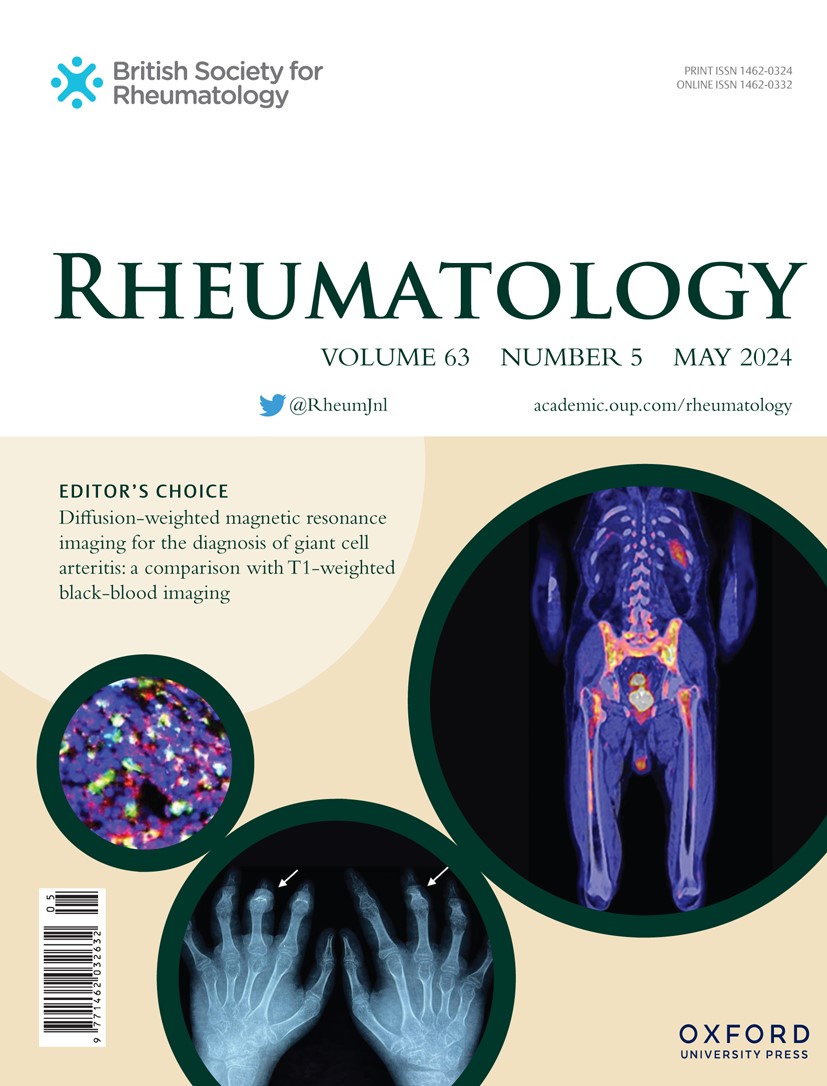Sleep and circadian parameters in Behçet's syndrome: a comparative analysis using actigraphy and questionnaires
IF 4.7
2区 医学
Q1 RHEUMATOLOGY
引用次数: 0
Abstract
OBJECTIVE Sleep disturbances are highly prevalent in Behçet Syndrome (BS) patients. Within this population, sleep disturbances are frequently associated with active disease and comorbid fibromyalgia. However, possible sleep impairments in BS patients without these conditions remain poorly explored, along with BS patients’ obstructive sleep apnea (OSAS) risk and circadian rhythm preferences. We aimed to address these research gaps through a cross-sectional study comparing sleep and circadian parameters between BS patients, with or without active disease and comorbid fibromyalgia, and healthy controls (HCs). METHODS Participants’ sleep and circadian parameters were evaluated objectively via actigraphy and subjectively through the Pittsburgh Sleep Quality Index and the reduced Morningness-Eveningness Questionnaire. A comprehensive clinical evaluation investigated sociodemographic data, disease activity and comorbid fibromyalgia. Possible predictors of sleep and circadian parameters were tested estimating linear regression models. RESULTS 45 BS patients and 61 age-, BMI-, sex-, and smoking habits-matched HCs were enrolled. Only BS patients with active disease and/or fibromyalgia showed significantly lower sleep quality, significantly higher sleep fragmentation, and a tendence towards less robust circadian rhythms compared to other participants. Instead, BS patients without those conditions did not significantly differ from HCs in sleep and circadian parameters. Furthermore, a higher actigraphically-determined OSAS risk was found in all BS patients compared to HCs. CONCLUSIONS Active disease and fibromyalgia are associated with sleep and circadian rhythm disturbances in BS patients. Screening for sleep and circadian rhythm disturbances may be advised in BS patients with these conditions, while OSAS screening may be recommended in all BS patients with sleep disturbances.behaperet综合征的睡眠和昼夜节律参数:使用活动记录仪和问卷的比较分析
目的:睡眠障碍在behaperet综合征(BS)患者中非常普遍。在这一人群中,睡眠障碍通常与活动性疾病和共病纤维肌痛有关。然而,没有这些条件的BS患者可能存在的睡眠障碍,以及BS患者的阻塞性睡眠呼吸暂停(OSAS)风险和昼夜节律偏好仍未得到充分探讨。我们旨在通过一项横断面研究来解决这些研究空白,比较BS患者(有或没有活动性疾病和共病纤维肌痛)和健康对照(hc)的睡眠和昼夜节律参数。方法采用活动记录仪客观评价被试的睡眠和昼夜节律参数,主观上采用匹兹堡睡眠质量指数和精简的早晚性问卷。一项全面的临床评估调查了社会人口统计数据,疾病活动和共病纤维肌痛。估计线性回归模型测试了睡眠和昼夜节律参数的可能预测因子。结果纳入了45例BS患者和61例年龄、BMI、性别和吸烟习惯匹配的hc。与其他参与者相比,只有伴有活动性疾病和/或纤维肌痛的BS患者表现出明显较低的睡眠质量,明显较高的睡眠碎片化,以及较弱的昼夜节律趋势。相反,没有这些症状的BS患者在睡眠和昼夜节律参数方面与hc患者没有显著差异。此外,与hcc患者相比,所有BS患者的OSAS风险更高。结论:活动性疾病和纤维肌痛与BS患者的睡眠和昼夜节律紊乱有关。可能建议对患有这些疾病的BS患者进行睡眠和昼夜节律障碍筛查,而可能建议对所有患有睡眠障碍的BS患者进行OSAS筛查。
本文章由计算机程序翻译,如有差异,请以英文原文为准。
求助全文
约1分钟内获得全文
求助全文
来源期刊

Rheumatology
医学-风湿病学
CiteScore
9.40
自引率
7.30%
发文量
1091
审稿时长
2 months
期刊介绍:
Rheumatology strives to support research and discovery by publishing the highest quality original scientific papers with a focus on basic, clinical and translational research. The journal’s subject areas cover a wide range of paediatric and adult rheumatological conditions from an international perspective. It is an official journal of the British Society for Rheumatology, published by Oxford University Press.
Rheumatology publishes original articles, reviews, editorials, guidelines, concise reports, meta-analyses, original case reports, clinical vignettes, letters and matters arising from published material. The journal takes pride in serving the global rheumatology community, with a focus on high societal impact in the form of podcasts, videos and extended social media presence, and utilizing metrics such as Altmetric. Keep up to date by following the journal on Twitter @RheumJnl.
 求助内容:
求助内容: 应助结果提醒方式:
应助结果提醒方式:


